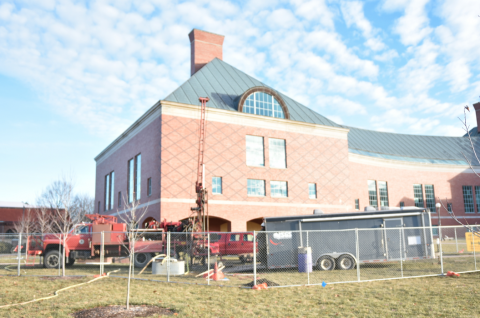You are here
Integrating Groundwater Resources and Geothermal Energy for Water-Energy Security and Resilience (In Progress)
Recent Project Updates
-
4/8/2023Presentation regarding the integrating groundwater and geothermal resources and applications on the UIUC campus.
-
12/7/2021Sharon Irish attended the NY-GEO Webinar: Public and Private Thermal Utilities - Where It's Working & Why and found out that there's a geothermal loop at Thomas Paine School in Urbana.The webinar flyer is attached.
Project Family
-
iSEE Campus as a Living Lab (CALL) Projects
- Adaptive Aluminum Tensegrity Structure as a Bike Parking Canopy
- Addressing Community Health Disparities from Hazardous Waste
- Agrivoltaics: Crop Production and Solar Panels on the Same Land
- City Traffic as a Reservoir System
- Creating Adaptable Autonomous Systems for Energy-Efficient Buildings
- Environment-Enhancing Food, Energy, and Water Systems
- Faculty/Staff Crowdsourced Community Program
- Geothermal: Thermo-Hydraulic Properties of Glacial Tills
- I-PLACES Living Laboratory
- Integrating Groundwater Resources and Geothermal Energy for Water-Energy Security and Resilience
- Student Mobility on and around the Illinois campus
- Testing Geopolymer Performance in a Geothermal Exchange System
- Thermochemical Batteries: Turning Waste Heat into an Energy Source
- Towards Zero Waste: Automated Waste Classification via Computer Vision
- Wind Turbine/Pavilion Integration for Electricity Generation
Associated Collections
Description
Funded in Spring 2020, this project aims to enhance water and energy security and resilience in urban systems, agricultural applications, and military bases by using groundwater resources and geothermal energy as an integrated system. Potential applications will improve military readiness and urban resilience to climate change by providing reliable indoor climate control and uninterrupted access to water.
Contingency military bases will benefit from a rapidly deployable system and a reduced logistics burden. This development will provide climate resilience under extreme weather conditions by using advanced storage technologies for water and energy as a sustainable infrastructure.
Background
Purpose of the Work: Campus Connection
A major drawback of current practice is that there are very limited tools to provide powerful simulations of surface and groundwater interactions coupled with heat transfer. Existing tools typically require a long and exhaustive learning process. On the contrary, MODFLOW — a groundwater flow model — is a free, widely used program developed by the U.S. Geological Survey (USGS) in 1988. MODFLOW has been well managed and consistently updated over the years to incorporate the most advanced coding capacity.
Using iSEE seed funding, researchers will initiate the development of a heat transport model in MODFLOW to integrate groundwater flow with geothermal exchange, enabling a much larger working force to contribute to the research and development of integrating groundwater resources and geothermal energy as an innovative sustainable infrastructure. Moreover, this development would enhance current U of I research and education activities on groundwater/geothermal integrations and the dynamic water cycle of groundwater, surface water, and the atmosphere.
The team will use abundant campus geothermal projects funded by the Student Sustainability Committee (SSC) and iSEE and a geothermal deep direct-use feasibility study funded by the U.S. Department of Energy (DOE) and ISGS, then will expand on these projects by preparing proposals to three potential federal agencies — DOE, the U.S. Department of Defense, and the U.S. Geological Survey, based on current collaborations with these three agencies.
Project Team
-
Project Leader:
Yu-Feng Forrest Lin, Principal Research Hydrogeologist, Illinois State Geological Survey; Director, Illinois Water Resources Center at the Prairie Research InstituteTeam Members:
- Co-PL: Tugce Baser, Assistant Professor, Civil and Environmental Engineering
- Co-PL: Mohamed Attalla, Executive Director, Facilities & Services
- Co-PL: Praveen Kumar, Lovell Professor, Civil and Environmental Engineering
- Franklin Holcomb, Ph.D. Candidate, Civil and Environmental Engineering
Themes
-
Primary Theme:

